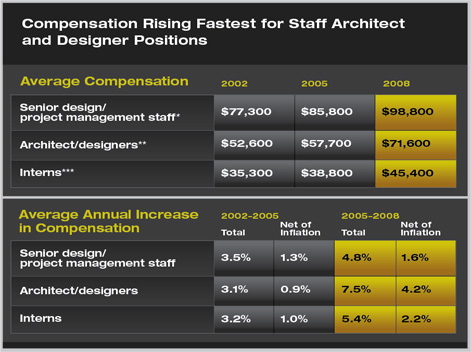| New AIA Survey Indicates Strong Gains in Compensation
Summary: Compensation gains for architecture staff positions have significantly outpaced compensation gains in the broader economy in recent years, according to the newly released 2008 AIA Compensation Survey. While the U. S. Department of Labor’s Employment Cost Index show that overall compensation gains among the private sector workforce increased less than 19 percent between the first quarter of 2002 and the first quarter of 2008, the new AIA surveys point to gains approaching 30 percent over the same six-year period. The report indicates that growth in nonresidential construction activity has increased the need for architecture staff at firms, which has helped to force up compensation levels.
Nearly 6 percent annual increase for the last three years
The report also indicates that compensation for architecture positions increased by nearly 6 percent annually between 2005 and 2008. The positions that saw the greatest increases were Architect 1–3 positions and unlicensed design staff (positions with comparable years of experience). These mid-level positions generally have 5–15 years of architecture experience, and the gains for these positions averaged 7.5 percent a year between 2005 and 2008, or more than 4 percent above the overall rate of inflation over this period.

Note: Average annual compensation including overtime, bonuses, and other incentive compensation. Inflation measured by consumer price index. All items from U.S. Department of Labor.
*Includes director of design, director of operations, senior project designer, project designer, senior project manager, and project manager. In 2002 and 2005, includes department heads, senior managers, and project managers.
** Includes architects 1–3/designers 1–3. In 2002 and 2005, includes senior project architects/designers.
*** Includes interns 1–3.
Wealth of data
The 2008 AIA Compensation Survey includes a wealth of other information of interest to both individuals and firms. Compensation data is provided for 40 positions in 37 states and 41 metro areas. Newly included this year is coverage of Hawaii, Idaho, Nebraska, Nevada, New Mexico, North Dakota, and Oklahoma.
The report also includes the answers to questions such as:
- What is the difference in compensation between large firms and small firms?
- Which regions of the country have the highest intern compensation?
- How much is the typical salary increase offered by firms upon registration?
- What benefits are most frequently offered by firms?
- What is the average value of the benefits?
The 2008 AIA Compensation Survey report is available for purchase through the AIA Bookstore. In the interest of sustainability, the report is available in PDF format only this year. The full, 152-page report is available for $195 for AIA members and $249 for nonmembers. Nine regional reports are available for $75 each for AIA members, $125 for nonmembers. |



